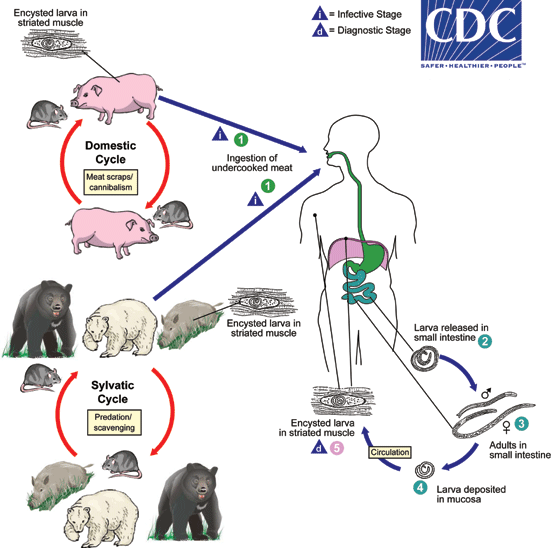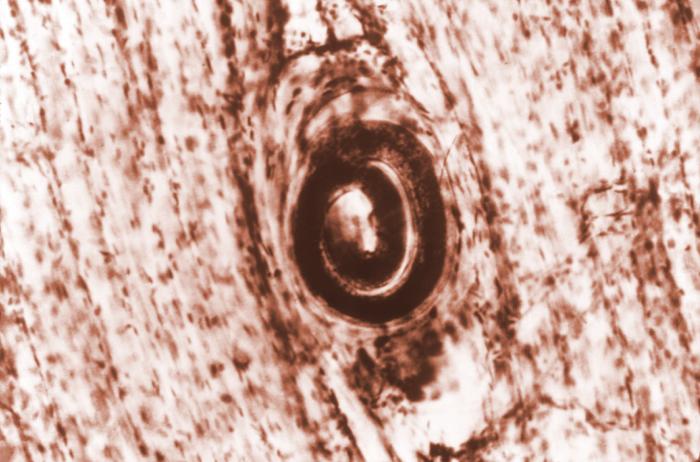Trichinosis pathophysiology
|
Trichinosis Microchapters |
|
Diagnosis |
|---|
|
Treatment |
|
Case Studies |
|
Trichinosis pathophysiology On the Web |
|
American Roentgen Ray Society Images of Trichinosis pathophysiology |
|
Risk calculators and risk factors for Trichinosis pathophysiology |
Editor-In-Chief: C. Michael Gibson, M.S., M.D. [1] Associate Editor(s)-in-Chief: Danitza Lukac
Overview
Trichinella spp. is usually transmitted to the human host by eating undercooked meat containing cysts of Trichinella spp. Following ingestion, exposure to gastric acid and pepsin release the larvae from the cysts and invade the small bowel mucosa. When an individual eats meat from an infected animal, Trichinella cysts break open in the intestines and grow into adult roundworms. Females are approximately 2.2 mm in length; males 1.2 mm. The life span in the small intestine is approximately four weeks. After 1 week, the females release more larvae that migrate through the bloodstream to voluntarily controlled muscles where they encyst. These organisms tend to invade muscle tissues, including the heart and diaphragm. They can also affect the lungs and brain.[1] Characteristic findings on microscopic histopathological analysis of the muscle, the nurse cell has a collagen capsule with larvae inside and is surrounded by cellular infiltrates.[2]
Pathogenesis
- Trichinosis is acquired by ingesting meat containing cysts (encysted larvae) (life cycle stage: 1) of Trichinella.
Enteral Phase
- After exposure to gastric acid and pepsin, the larvae are released (life cycle stage: 2) from the cysts and invade the small bowel mucosa.
- Thirty to 34 hours after the cysts were originally ingested, they develop into adult worms (life cycle stage: 3) (female approximately 2.2 mm in length, males 1.2 mm); life span in the small bowel is approximately 4 weeks.
- The adults worms mate. The production of larvae generally occurs within 5 days.
- The worms can only reproduce for a limited time. The immune system will eventually expel them from the small intestine.
- After 1 week, the females release larvae (life cycle stage: 4).
- The newborn larvae then use their piercing mouthpart (called the "stylet") to pass through the intestinal mucosa.
Parental Phase
- The newborn larvae enter the lymphatic vessels and then enter the bloodstream.
- The larvae travel by capillaries to various organs, such as the retina, myocardium, or lymph nodes; however, only larvae that migrate to skeletal muscle cells survive and encyst.
- Skeletal muscle cells act as nurse cells where larvae can develop and after weeks, months or years calcify.
- Encystment is completed in 4 to 5 weeks and the encysted larvae may remain viable for several years (life cycle stage: 5).[1][2][3]
Microscopic Pathology
- Males T. spiralis:
- Measure between 1.4 and 1.6 mm long and are more flat anteriorly than posteriorly.
- The anus can be found in the terminal (side) and they have a large copulatory pseudobursa on each side.
- Females T. spiralis:
- Are about twice the size of the males
- Have an anus found terminally
- The vulva is located near the esophagus
- The single uterus of the female is filled with developing eggs in the posterior portion, while the anterior portion contained the fully developed juveniles.[4]
- Muscle biopsy (hematoxylin and eosin stain):
- Nurse cell has a collagen capsule (thickness depends on Trichinella species) with larvae inside and surrounded by cellular infiltrates.[2]
References
- ↑ 1.0 1.1 Trichinosis. Wikipedia. https://en.wikipedia.org/wiki/Trichinosis. Accessed on January 22, 2016
- ↑ 2.0 2.1 2.2 Gottstein B, Pozio E, Nöckler K (2009). "Epidemiology, diagnosis, treatment, and control of trichinellosis". Clin Microbiol Rev. 22 (1): 127–45, Table of Contents. doi:10.1128/CMR.00026-08. PMC 2620635. PMID 19136437.
- ↑ Trichinellosis. CDC. http://www.cdc.gov/parasites/trichinellosis/biology.html. Accessed on January 26, 2016
- ↑ Trichinella spiralis. Wikipedia. https://en.wikipedia.org/wiki/Trichinella_spiralis. Accessed on January 26, 2016

